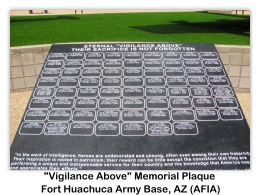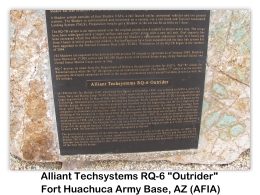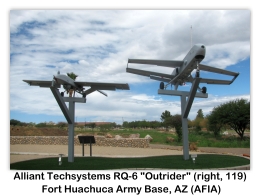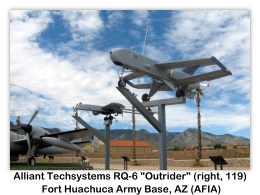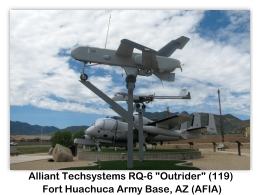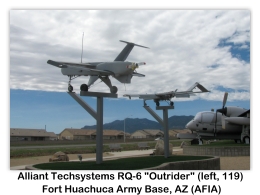


| Veteran's Memorial Park, Duncan | Arizona Guide | BMGR AF Auxiliary Field, Gila Bend |
Fort Huachuca — Fort Huachuca Memorial Air Park
Arizona Aviation Museum Guide
Fort Huachuca
Memorial Air Park
Hatfield Street and Irwin Street
Fort Huachuca, Arizona
Overview ³
Fort Huachuca is a United States Army installation under the command of the United States Army Installation Management Command. It is located in Cochise County, in southeast Arizona, about 15 miles (24 km) north of the border with Mexico. Beginning in 1913, for 20 years the fort was the base for the “Buffalo Soldiers”, the 10th Cavalry Regiment. During the buildup of World War II, the fort had quarters for more than 25,000 men. In 2010, Fort Huachuca has a population of roughly 6,500 active duty soldiers, 7,400 family members and 5,000 civilians. Fort Huachuca can have well over 18,000 people on post during the peek hours of 0700 and 1600, M-F, making it one of the busiest transient installations.
Sierra Vista, which annexed the fort in 1971, is located south and east of the post, and Huachuca City is to the north and east. Major tenants are the NETCOM/9th Signal Command (A) and the United States Army Intelligence Center. Libby Army Airfield is located on post and shares the runway with Sierra Vista Municipal Airport; it was on the list of alternate landing locations for the space shuttle, though was never used as such.
Fort Huachuca is also the headquarters of Army Military Auxiliary Radio System (MARS). Other tenant agencies include the Joint Interoperability Test Command, Information Systems Engineering Command (ISEC) and the Electronic Proving Ground.
The fort is also home to a radar-equipped aerostat, one of a series maintained for the Drug Enforcement Administration by Lockheed Martin. The aerostat is based northeast of Garden Canyon and, when extended, supports the DEA drug interdiction mission by detecting low-flying aircraft attempting to penetrate the United States.
The fort is also the home to the Western Division of the Advanced Airlift Tactics Training Center (AATTC) which is based at the 139th Airlift Wing, Rosecrans Air National Guard Base, Saint Joseph, Missouri.
History ³
What today is Ft. Huachuca was a new fort to counter the Chiricahua threat and to secure the border with Mexico. On March 3, 1877, Captain Samuel Marmaduke Whitside, accompanied by two companies of the 6th Cavalry, chose a site at the base of the Huachuca Mountains that offered sheltering hills and a perennial stream. In 1882, Camp Huachuca was redesignated a fort.
General Nelson A. Miles controlled Fort Huachuca as his headquarters and against Geronimo in 1886. After the surrender of Geronimo in 1886, the Apache threat was essentially extinguished, but the army continued to operate Fort Huachuca because of its strategic border position. In 1913, the fort became the base for the “Buffalo Soldiers”, the 10th Cavalry Regiment, which was composed of African Americans. It served this purpose for twenty years. During General Pershing's failed Punitive Expedition of 1916-1917, he used the fort as a forward logistics and supply base. From 1916-1917, the base was commanded by Charles Young, the first African American to be promoted to colonel. He left because of medical reasons. In 1933, the 25th Infantry Regiment replaced the 10th Cavalry at the fort.
With the build-up during World War II, the fort had an area of 71,253 acres (288.35 km²), with quarters for 1,251 officers and 24,437 enlisted soldiers. The 92nd and 93rd Infantry Divisions, both with African-American troops, trained at Huachuca.
In 1947 the post was closed and turned over to the Arizona Fish and Game Department. However, due to the Korean War, a January 1951 letter from the Secretary of the Air Force to the Governor of Arizona invoked the reversion clause of a 1949 deed. On February 1, 1951 The US Air Force took official possession of Ft. Huachuca, making it one of the few Army installations to have an existence as an Air Force Base. The Army retook possession of the base a month later, and reopened the post in May 1951 to train Aviation Engineers in air field construction as part of the Korean War build up. The engineers built today's Libby Army Airfield. After the Korean War, the post was again placed in an inactive status with only a caretaker detachment on May 1, 1953.
On 1 February 1954 Huachuca was reactivated after a seven-month shut-down following the Korean War. It was the beginning of a new era for this one time cavalry outpost, one which saw Huachuca emerge as a leader in the development of Electronic warfare. The Army's Electronic Proving Ground opened in 1954, followed by the Army Security Agency Test and Evaluation Center in 1960, the Combat Surveillance and Target Acquisition Training Command in 1964, and the Electronic Warfare School in 1966. In 1967, Fort Huachuca became the headquarters of the U.S. Army Strategic Communications Command (USSTRATCOM), which became the U.S. Army Communications Command in 1973; and U.S. Army Information Systems Command (USAAISC) in 1984. It is now known as the United States Army Network Enterprise Technology Command (NETCOM)/9th Army Signal Command.
The area is so desolate and barren, an old army description of the fort states, “It is the only fort in the Continental United States where you can be AWOL (absent without leave) for three days and they can still see you leaving”! Fort Huachuca was declared a National Historic Landmark in 1976.
In 1980, the 160th Special Operations Aviation Regiment conducted aircraft training exercises from Fort Huachuca in preparation for Operation Honey Badger. This planned rescue attempt was developed to try to rescue captive American personnel in Iran. It was developed in the wake of Operation Eagle Claw's failure. The environment near the fort enabled 160th SOAR pilots to train and simulate flying in the mountainous desert terrain of Iran.
Museums 3,4
Ft. Huachuca has two museums located in three buildings on Post. All are within a short walk from one another: (1) The Ft. Huachuca Museum takes up two buildings, its main museum (Bldg. 41401) and a spillover gallery called the Museum Annex (Bldg. 41305). It tells the story of the US Army in the American Southwest. (2) The second museum is The US Army Intelligence Museum which takes for its theme the evolution of the intelligence art within the US Army. It is in building 41411.
In addition to the two museums, Ft. Huachuca has a very nicely presented memorial air park featuring four Army aircraft.
Recently AFIA (A Friend In Arizona) visited the Fort Huachuca Army Base. At the intersection of Hatfield Street and Irwin Street, the United States Army has created a small memorial air park dedicated to their lost airmen. The air park currently contains two aircraft and two UAV's. The following U.S. Army aircraft are on display: (1) a AAI RQ-7B Shadow 200 UAV, (2) an Alliant Techsystems RQ-6 Outrider UAV, (3) Beech RC-12G Crazyhorse, (Army 80-23372) and (4) a Grumman OV-1D Mohawk (Army 67-18930).
NOTE: The post is an active military installation. Visitor passes for US citizens are available at the front gate with a valid drivers license, vehicle registration, proof of vehicle insurance or rental agreement. All passengers 13 and older must also have photo ID's. Fort Huachuca is occasionally closed for maneuvers. International visitors are not permitted access, unless they are sponsored and escorted by authorized personnel.
AFIA Photos 4
Static Aircraft Displays at Fort Huachuca Army Base, Arizona, (8/3/2011 photo by AFIA)
AAI RQ-7B Shadow 200 (1051), Fort Huachuca Army Base, Arizona, (8/3/2011 photos by AFIA)







Alliant Techsystems RQ-6 Outrider (119), Fort Huachuca Army Base, Arizona, (8/3/2011 photos by AFIA)
Beech RC-12G Crazyhorse (Army 80-23372, c/n BP-013), Fort Huachuca Army Base, Arizona, (8/3/2011 photos by AFIA)
Grumman OV-1D Mohawk (Army 67-18930, c/n 131c), Fort Huachuca Army Base, Arizona, (8/3/2011 photos by AFIA)
Special Thanks
A very special thanks to AFIA … A Friend in Arizona for providing us with photos of the aircraft at this location.
References
- Fort Huachuca, website
- Google Earth, Satellite Image
- Wikipedia, Fort Huachuca, Arizona
- AFIA (A Friend in Arizona), Aircraft Photos
Copyright © 2014 Skytamer Images, Whittier, California
All rights reserved


